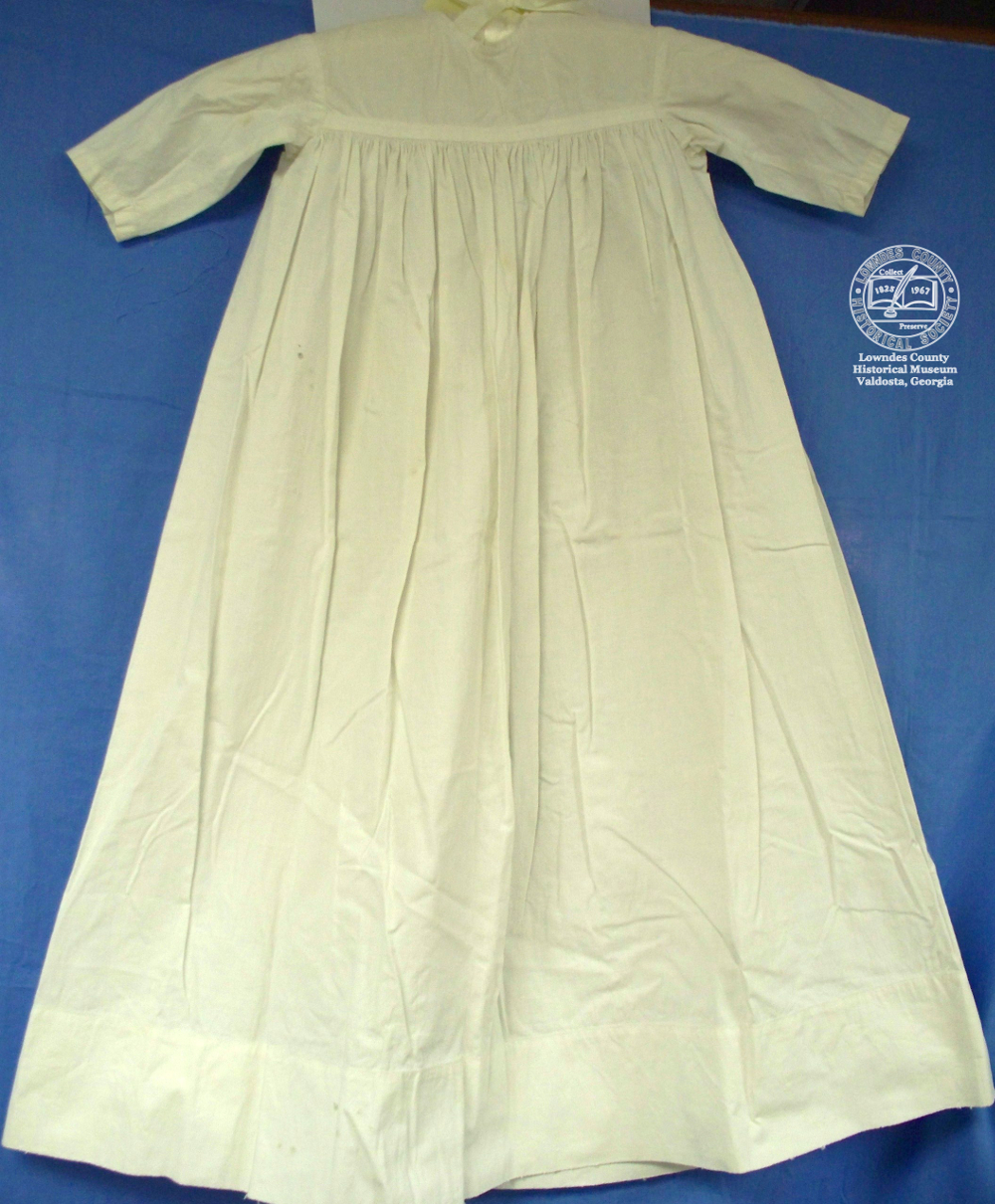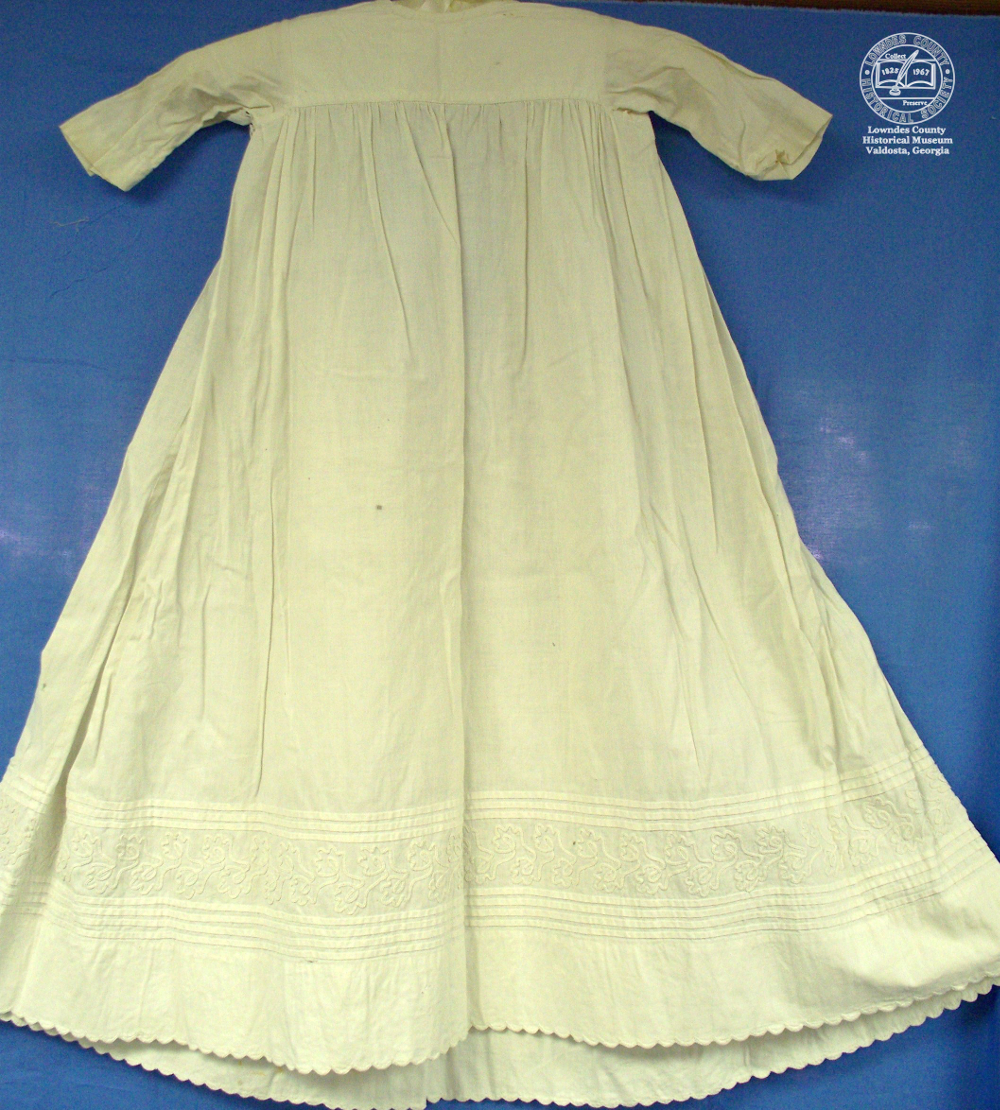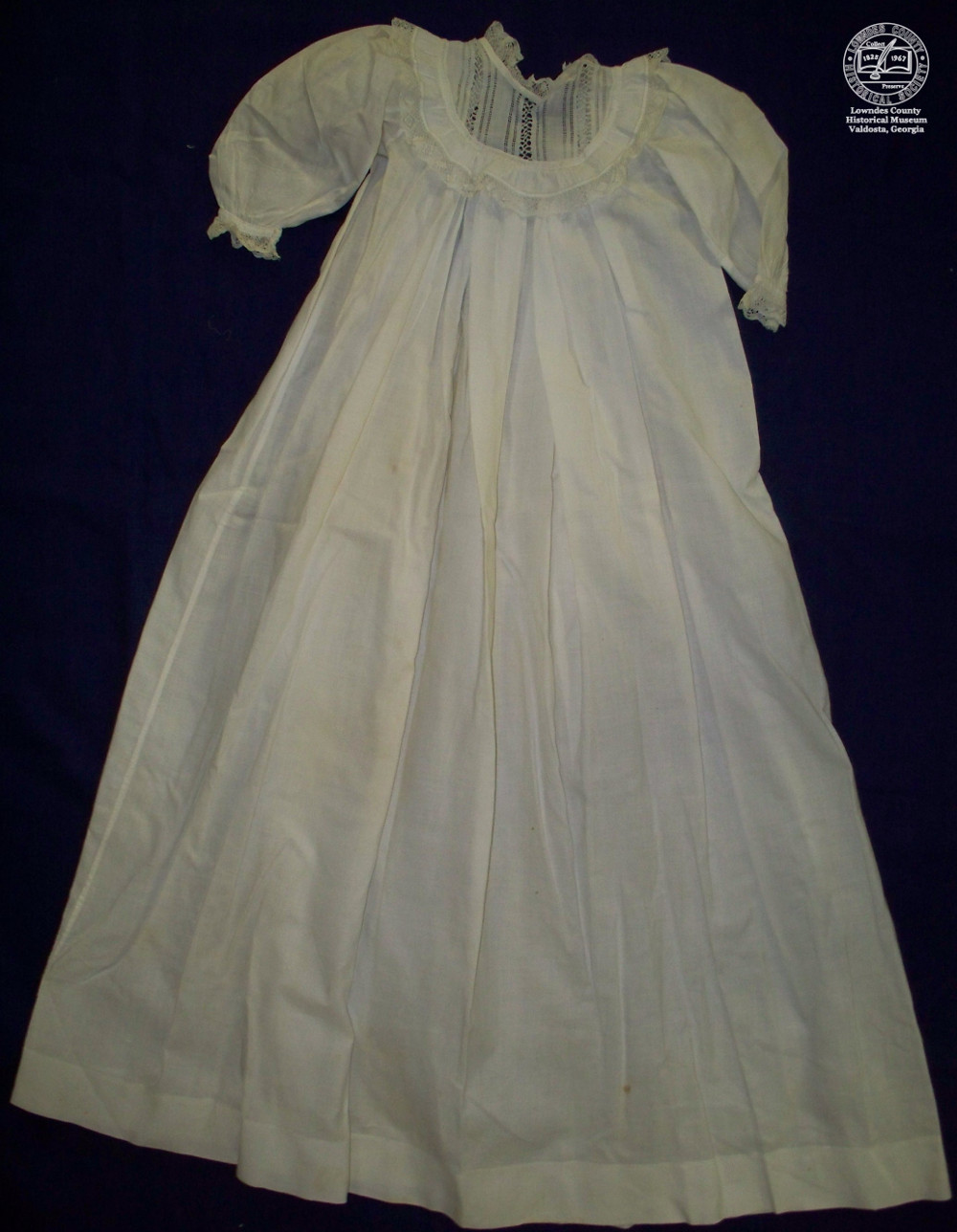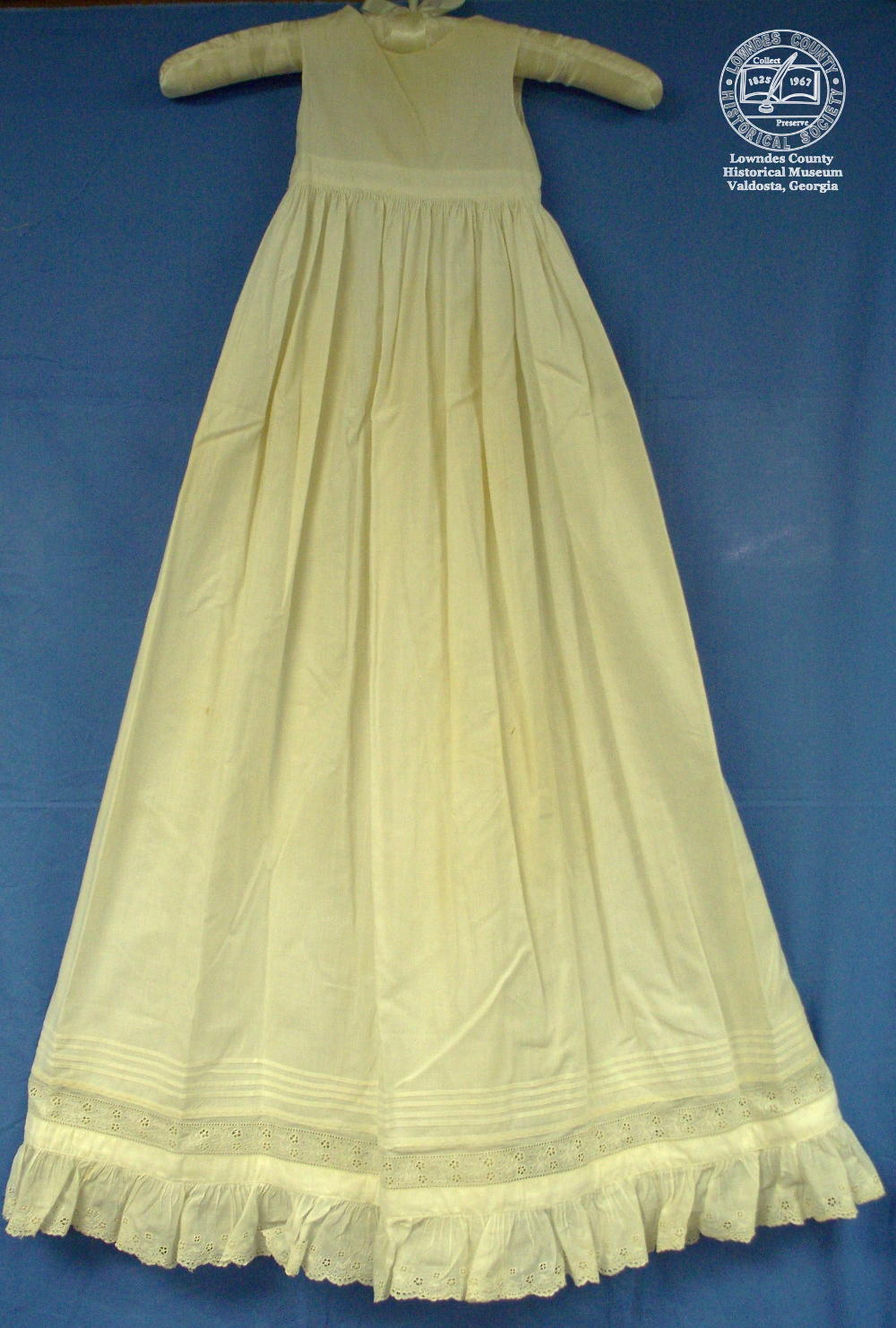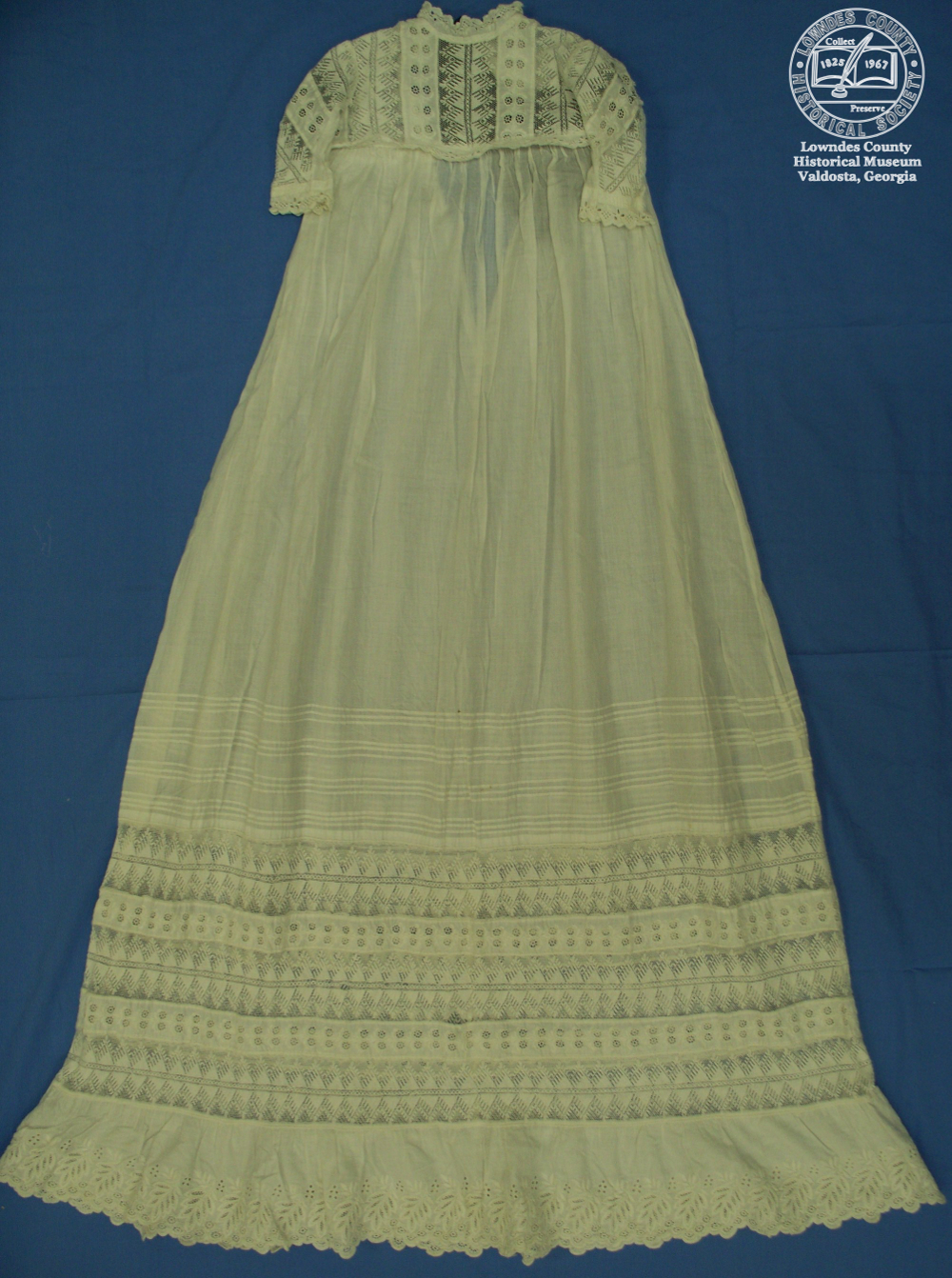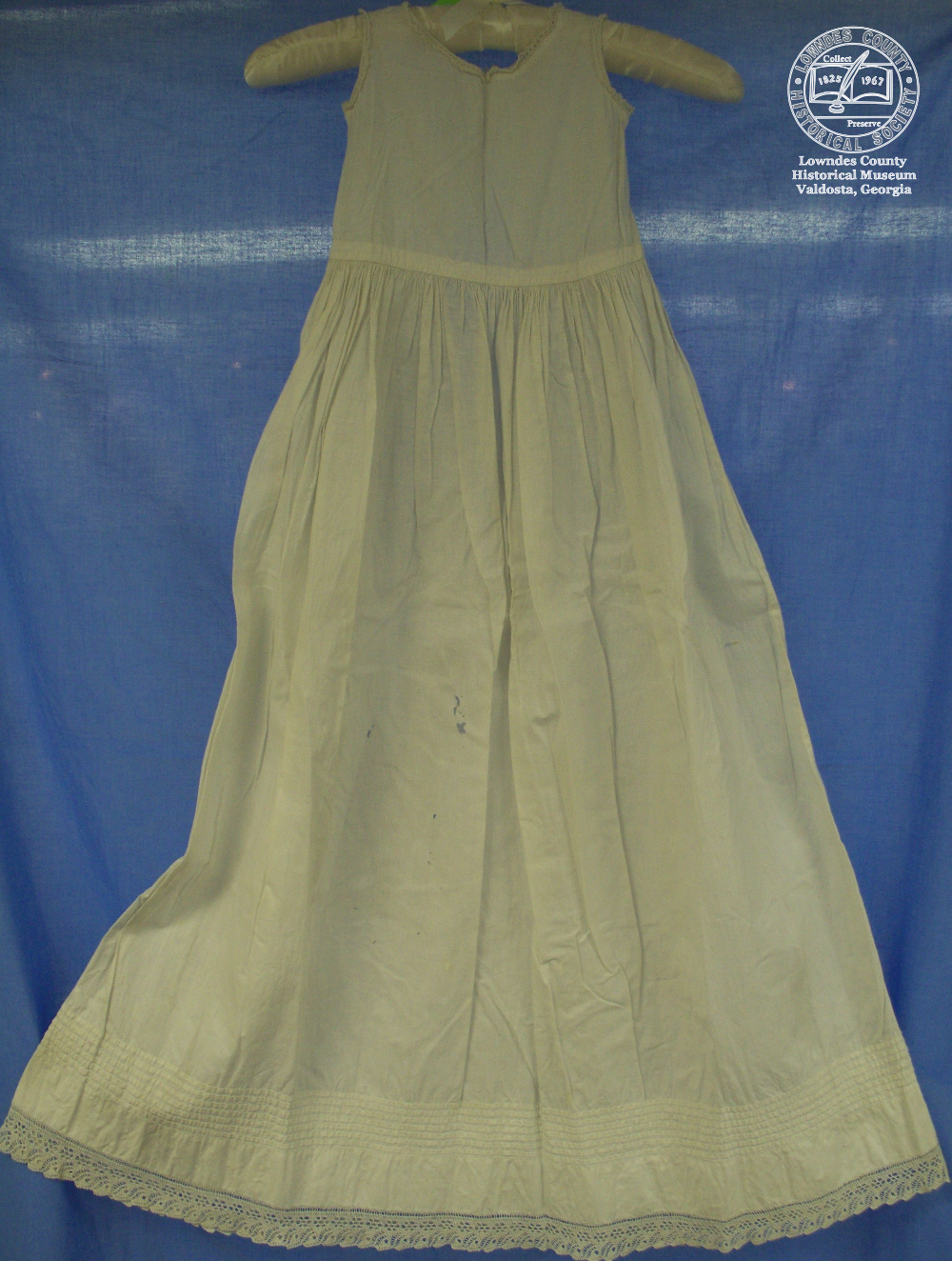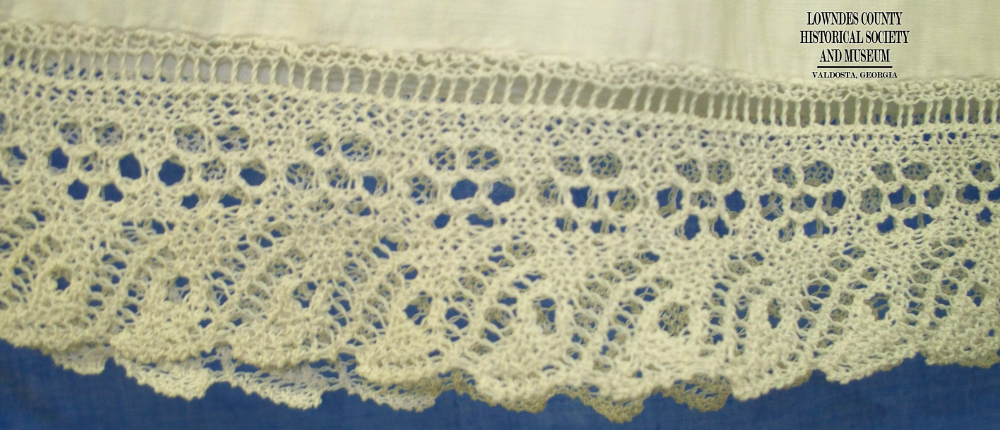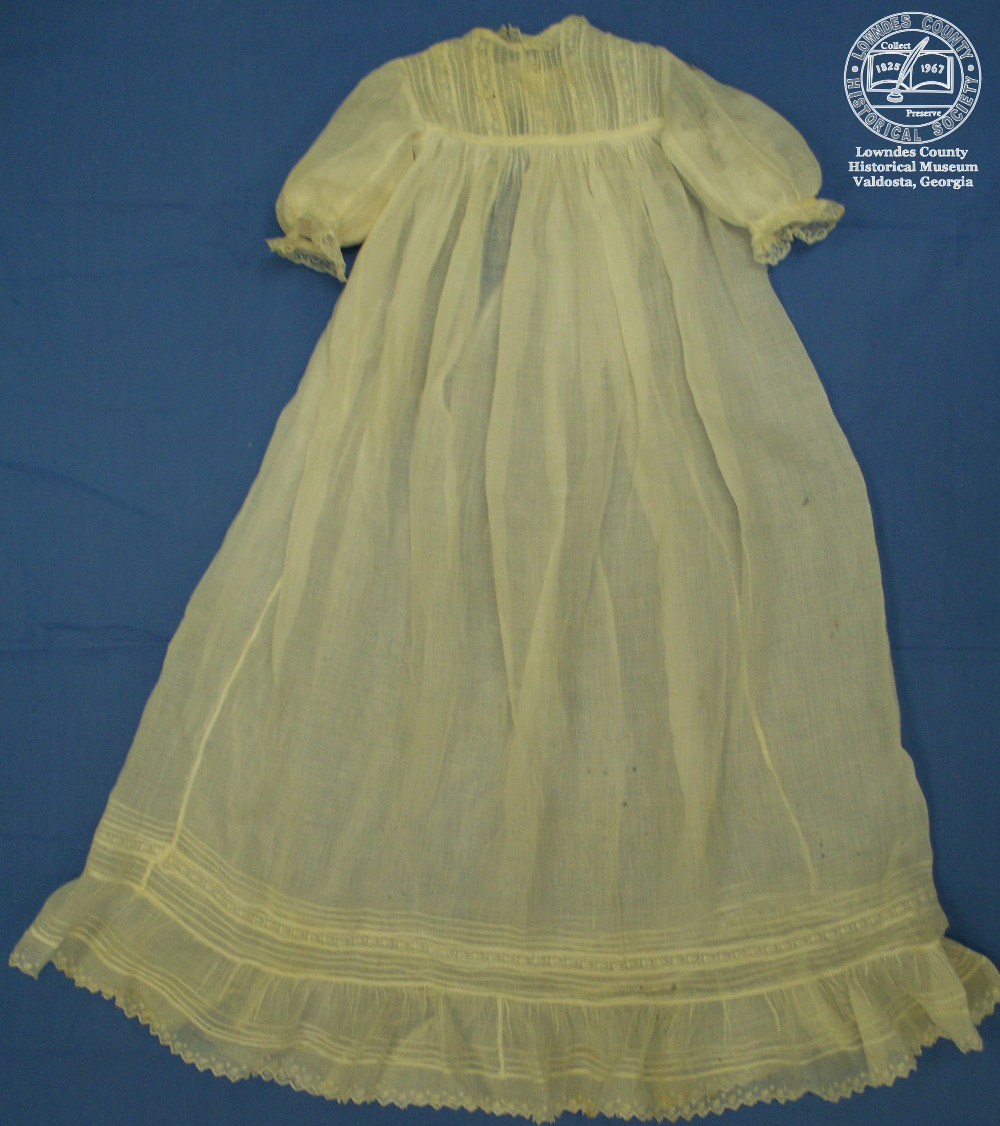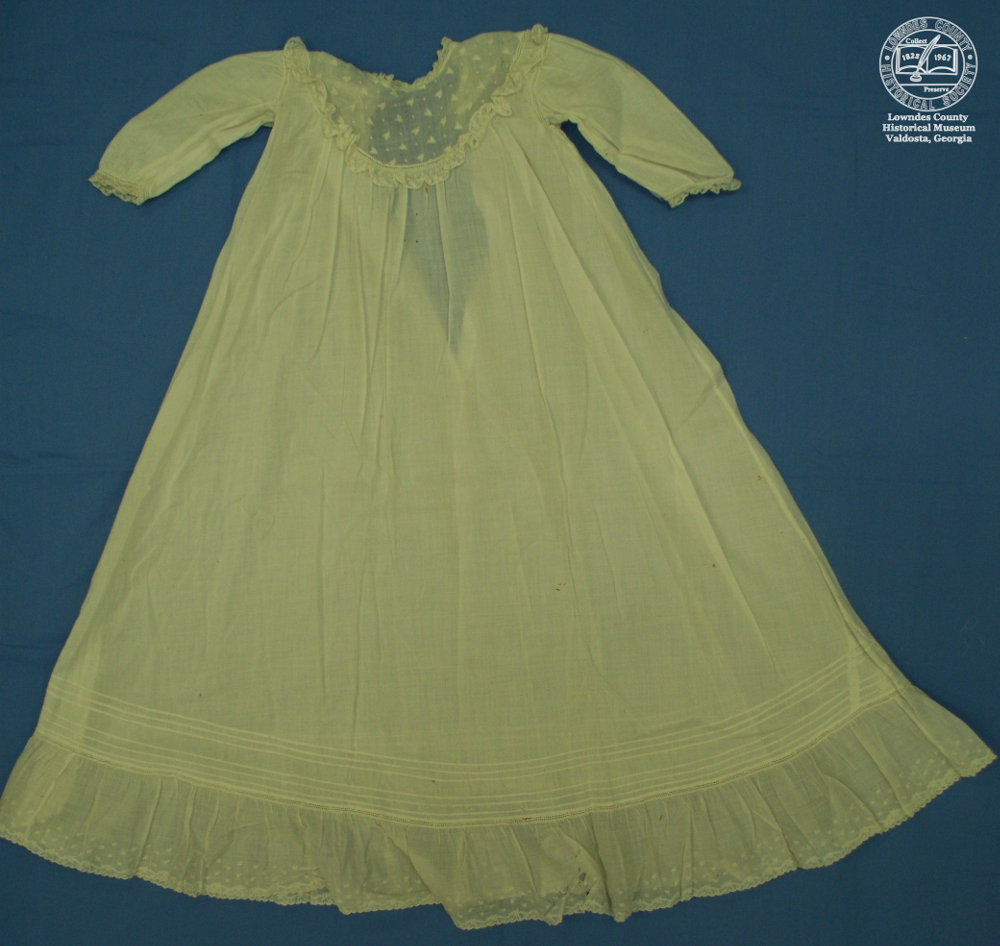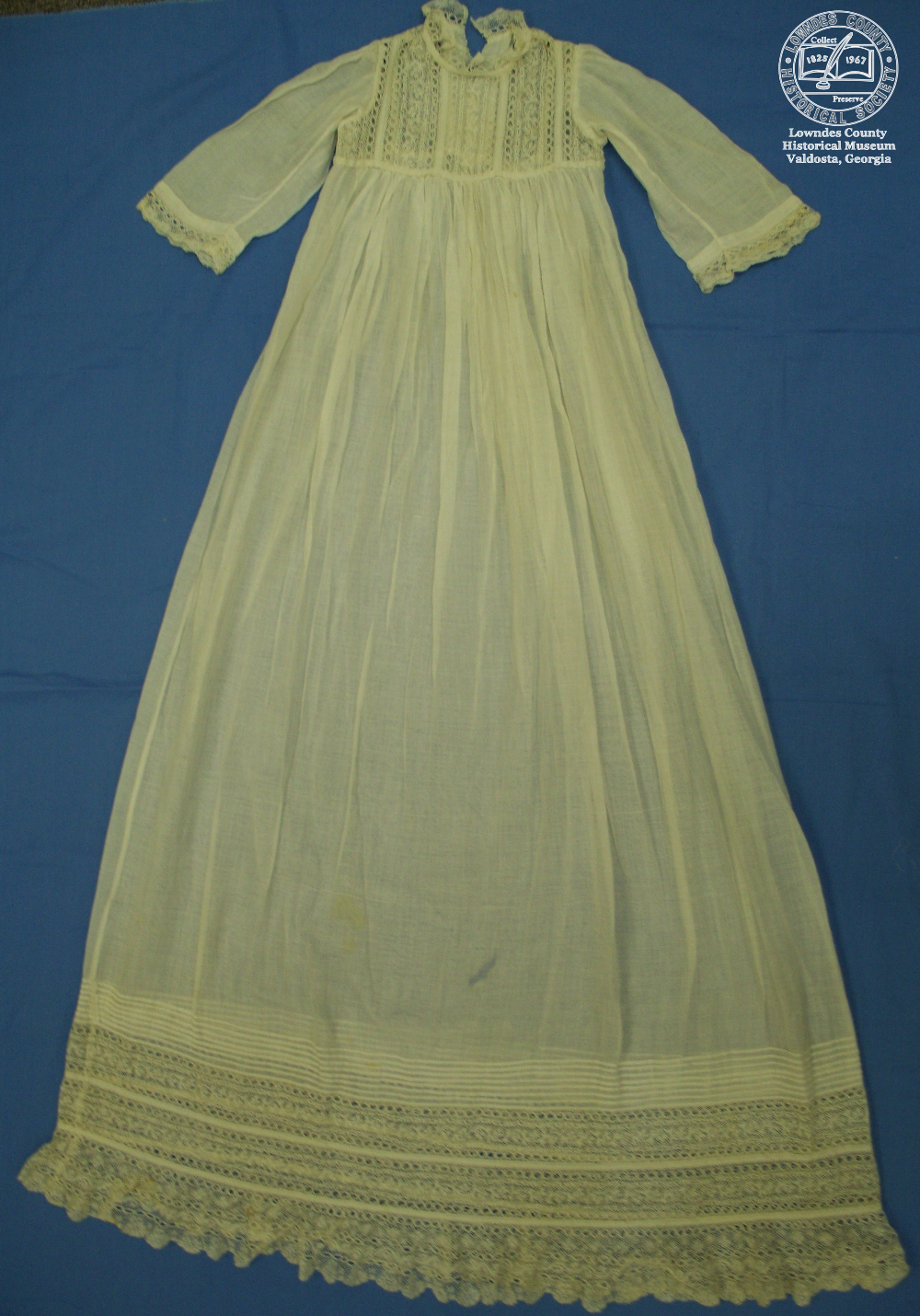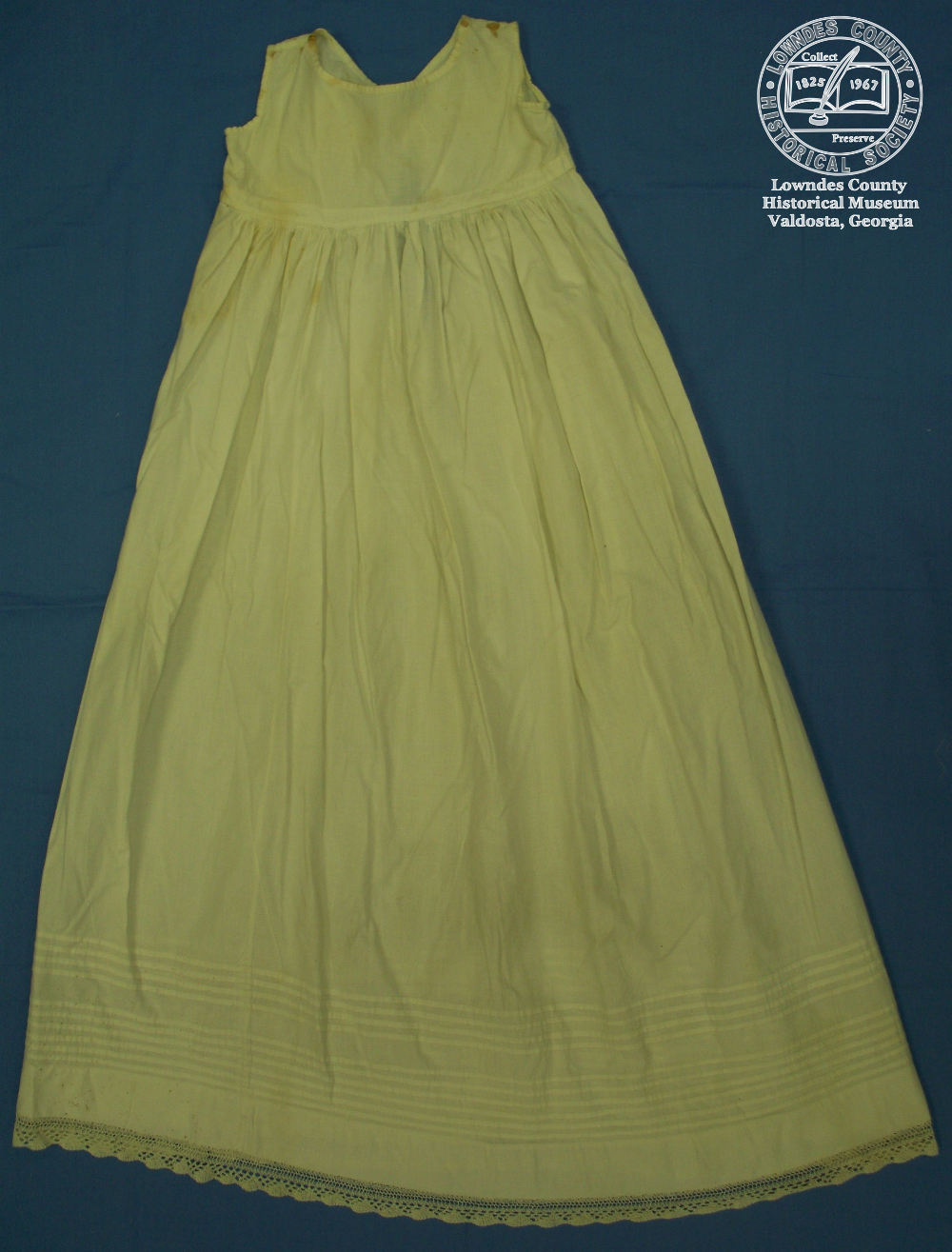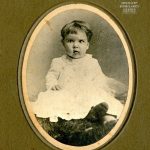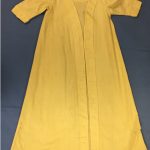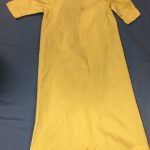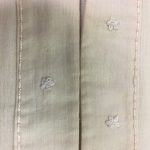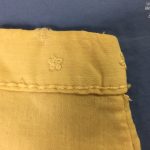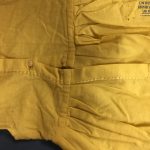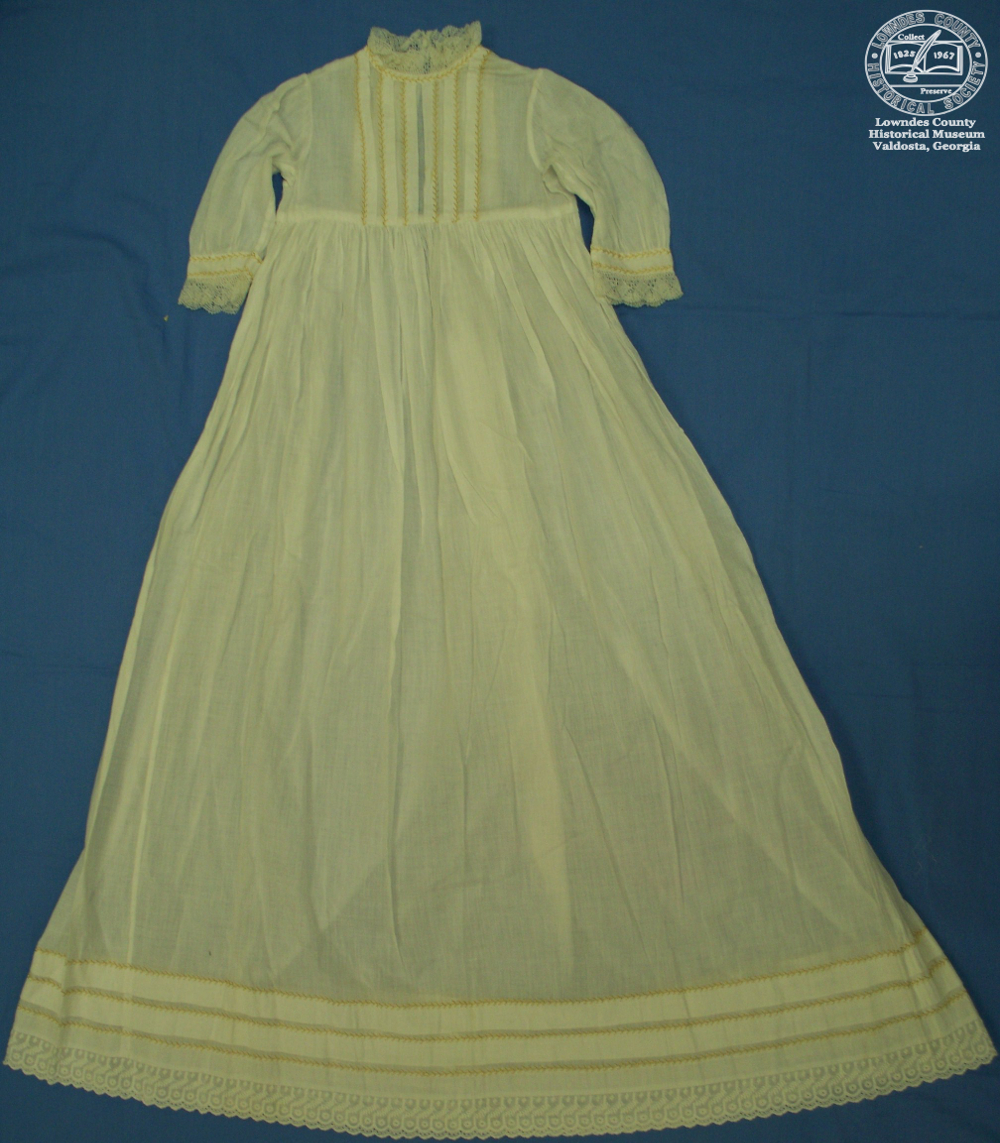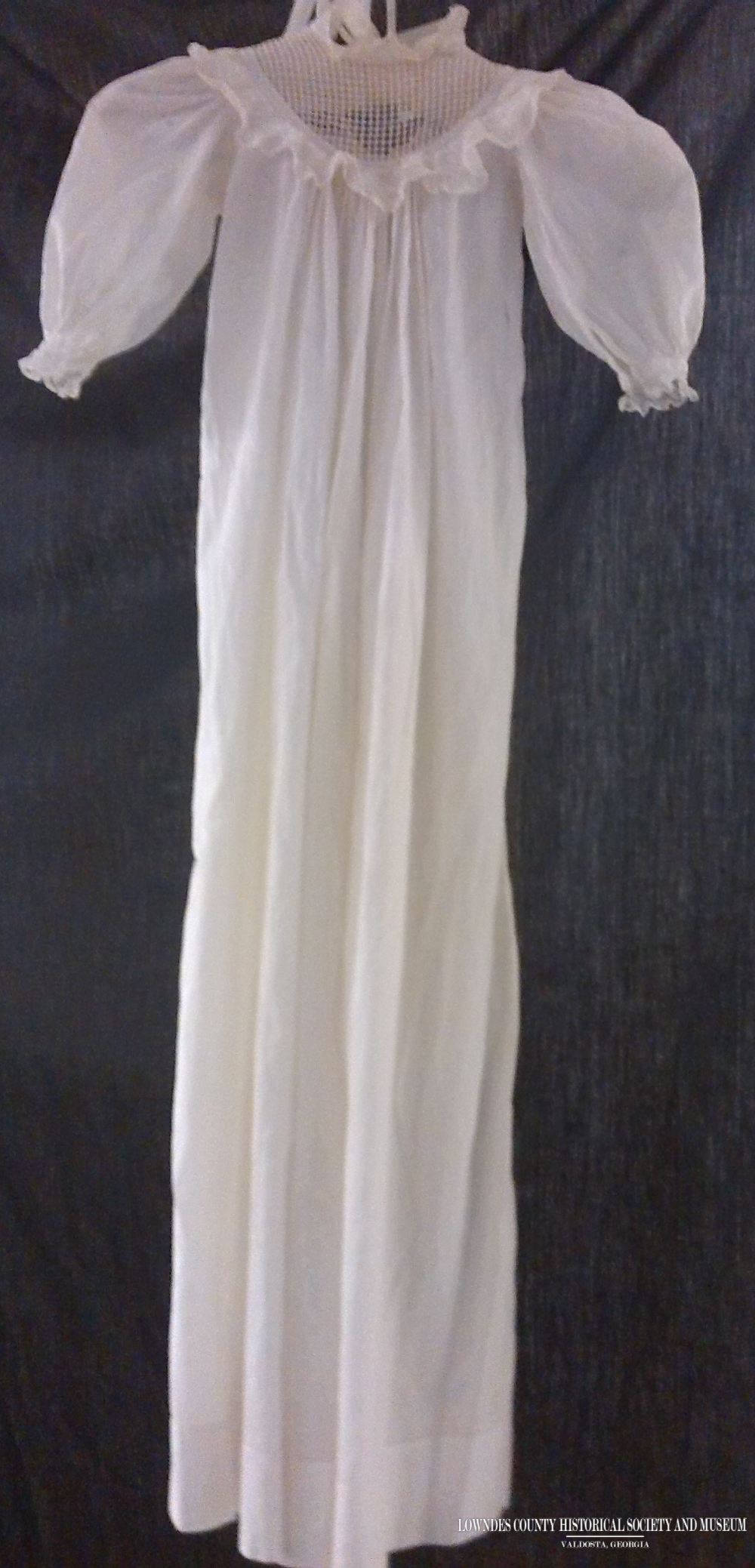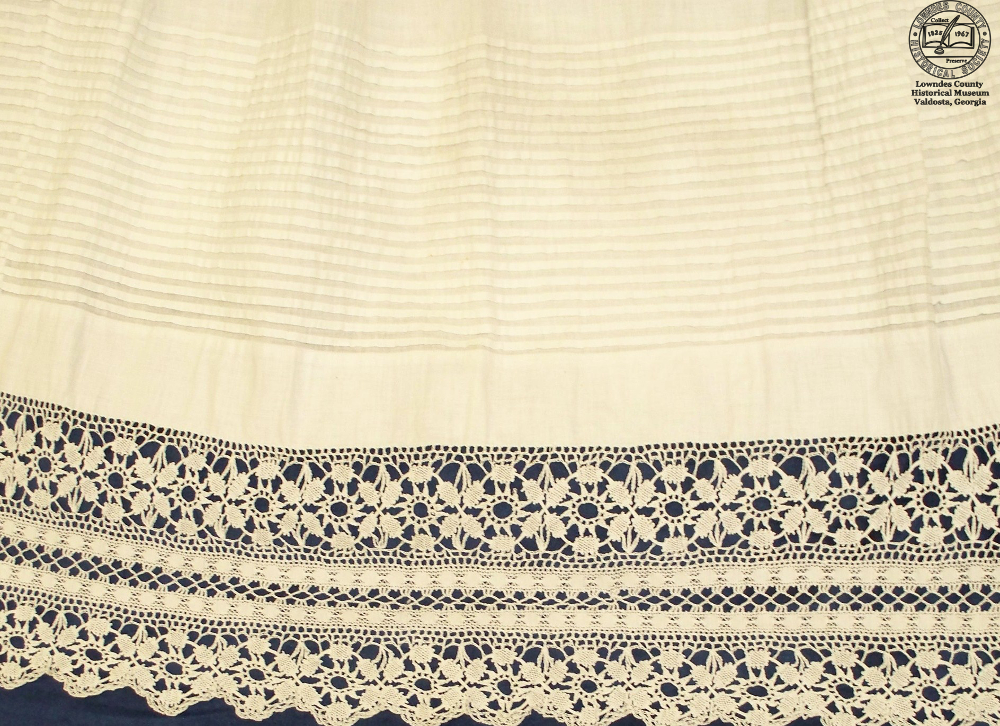 A Christening gown, a long decorative dress usually constructed with fine fabric, lace, and sometimes hand embroidery, is made for a baby’s special occasion and is often an heirloom piece passed down and used by generations in a family. Other less elaborate long dresses were historically used as everyday clothing for boys and girls alike before the turn of the century. Little boys graduated from their long dresses into shorter button- on knickers or shorts and later to pants. Shorter length dresses were fashionable after the turn of the century for girls and baby boys in long gowns became increasingly less fashionable.
A Christening gown, a long decorative dress usually constructed with fine fabric, lace, and sometimes hand embroidery, is made for a baby’s special occasion and is often an heirloom piece passed down and used by generations in a family. Other less elaborate long dresses were historically used as everyday clothing for boys and girls alike before the turn of the century. Little boys graduated from their long dresses into shorter button- on knickers or shorts and later to pants. Shorter length dresses were fashionable after the turn of the century for girls and baby boys in long gowns became increasingly less fashionable.
The museum greatly appreciates those in Lowndes County and its vicinity for donating their baby heirloom clothing and accessories which reflect the thoughts, culture, and artistic craftsmanship of this area. The museum strives to maintain personal information on each textile it receives including who the piece belonged to, where it was made, by whom and when it was made, and photos of the original owner and or creator of the piece as well as other information pertinent to each piece. If you recognize any of the textiles on this site or the names that might be associated with the piece and you have more documented information, please call or e-mail the museum. Any portion of information no matter how small would be extremely appreciated. Photos and documents may be scanned and returned at your request.
Many of the gowns are excellent visual studies, teaching garment construction, hand embroidery, and handmade lace techniques, as well as fashion design and fabric construction of a specific era. Because of the limited exhibit area in the museum and for preservation purposes, textiles are rotated in the museum. Many of the textiles shown here are not on display at this time. However, they are available for further study by contacting the museum one week prior to a planned visit. Please request specific textiles you wish to study.
Boy Gowns Swain 1984-438-01a,b TB20 R5Sb2
These two boy gowns (pictured below) were made for the sons of Maggie Aline Parrish Swain (1877-1963) and Albert Norris Swain (b. 1875). The Swains had five children: Albert N Swain (b.1906), Ansel Swain (b1910), Emeliza Swain (1913), Margaret Swain (1915) and Will N Swain (1918). Valdostans Ansel Alexander Parrish (1846-1918), a confederate solider, and Mary Emma Peeples (1856-1928) were the maternal grandparents of the five children. Maggie and Albert Swain were married in 1874 and lived their lives and raised their family in Valdosta. It is interesting to note that the two sisters of the brothers who wore these outfits, Miss Margaret and Miss Emeliza Swain donated these historic textiles to the museum in 1984.
Since the Swain children were born between 1906-1918 and the gowns are sized for a one to two year old, the dates for these boys dresses are between 1907 and 1920. However, by the early 1920’s, little boys were more likely dressed in rompers; therefore, these dresses were probably for the older two boys dating these gown more specifically from 1907-1912.
Boys Plain Dress 84-438-1b TB 20R5Sb2
Bodice: Cropped, plain
Long sleeve
Total Length of dress: 28 inches
Width of skirt 24 1/2 inches
Special features: Handmade button holes Currently not on display
Fancy Boy’s Dress 84-438-1a TB20
Bodice: Cropped, plain
Long sleeve
Total Length of dress: 30 inches
Width of skirt 24 1/2 inches
Special features: Handmade button holes Currently not on display
History: This is the second of the two boys dresses from the Swain Collection. Description: The two button holes on this dress are perfectly handmade but the rest of the garment is machine made including the scalloped hem. A beautiful soutache braid is attached by machine straight stitch to the skirt hem in a continuous leaf design and situated between rows of 1/4 inch tucks.
In comparing the two dresses from the Swain collection, it was concluded they were both made from the same pattern; however, the fancy dress was made of a slightly finer cotton material. The bodice and sleeves on both dresses are exactly the same size. However the fancy dress is two inches longer than the plain dress skirt. Under magnification, small stitching holes and remnants of thread are evidence of removed lace. It was concluded that the dress above had a two inch lace.
Application: When examining textiles, look to find evidence of missing pieces, alterations, and mending. These become part of the story of the individual piece. In addition, today’s fashion predispose us to believe that soutache braid is only found as decoration on suits and heavier items; however, this baby dress demonstrates the effective application on more delicate items as well. The couching stitch used to apply this soutache braid may also be used in other embroidery techniques. Such techniques include or nué and gold-work that utilize gold, silver, and silk threads. Any type of “thread” that is too heavy, delicate, or rough to go through a needle or the base fabric being used may be couched to the fabric. Couching can also show as much or as little of the main thread as desired leaving much room for design and experimentation. Since couching allows the embroidery thread to sit on top of the fabric, the design can be very fluid allowing shapes in any form desired as evident in this little dress. The couching stitch is very versatile as a embroidery and utilitarian stitch a good stitch to master and add to a “basket of tools.”
Round Yoke Dress with Puff Sleeves UNK#1 TB20R5Sb2
Bodice: round yoke, encloses in back with beauty pins
Dress length:38 inches
Dress width:37 inches
Special features:handmade bobbin lace
Currently not on display
History: Unfortunately, a definite history on the dress below is unknown at this time. If you have any information on this dress, please contact the museum textile curator.
Description: This fine linen lawn dress features a beautiful round yoke with handmade drawn thread work. A 3/8 inch machine embroidered band joins the yoke to a ruffled fabric edged with bobbin lace. To unify the dress, the same application is used on the sleeve band. The neckline is finished with a 1/4 inch plain band and gathered bobbin lace edging. Typical of a Christening dress, the back placket is meant to be closed with beauty pins so no buttons or button holes were made. With the exception of the drawn thread embroidery and the bobbin lace, this dress is constructed by machine, including a straight stitched 2 inch hem and the 1/4 inch french seams. The dress is stamped on the inside with 311 or 3″ which may suggest that this dress was purchased possibly overseas in a town where the bobbin lace was made. It could have been brought back the the US for resale or purchased by a consumer on a trip.
Applications: This dress features both hand lacework and bobbin lace each of which would be an interesting study.
Long Slip With Eyelet Lace 77-152-01TB20R5Sb2
Bodice: Full Plain, jewel neckline, 3 buttons in back
Skirt length: 34 inches
Skirt width: 48 inches Currently not on display
History:This slip is attributed to Gladys Hogan (77-152-01). It is made of the same pattern and is the same size as the “Long slip with woven bands” that follows.
Gladys Hogan got her degree in education from the Woman’s College of Georgia and taught history at Valdosta High School through 1961.
Description: This little slip is made of sturdy cotton with a tight weave. It has a plain bodice with the arm holes and neckline rolled over twice and straight stitched down hemmed a precise 1/8 of an inch. The bodice encloses in the back with three machine made button holes and tiny buttons. The skirt is then gathered to the bodice and enclosed in a 7/8 band. The skirt bottom is decorated by 4 rows of ¼ in tucks, an applied ¼ embroidered band in white, and a 1 inch eyelet insertion and ending with a gathered hem of 2 6/8 inch gathered eyelet lace edging. It employs French seams and is constructed by machine.
Long Slip With Woven Bands 77-152-10TB 20
Bodice: Full, jewel neckline, 3 buttons in back
Skirt Length: 34 inches
Skirt width: 71 inches one French seam
Machine made with handmade button holes, lace whipped by hand Currently not on display
General History: This slip/ dress is attributed to Gladys Hogan (Acq 72-82-10). One of the slips on her acquisition sheet is an “extra long baby petticoat in white.” Certainly this slip could be referred to as a petticoat which was generally fancier than a slip. Petticoats often gave a dress volume and shape and also provided opaqueness to fine delicate fashion skirt material. In addition, petticoats were also designed to be beautiful so that with movement, a glimpse of surprise lace and fashion could be viewed from beneath the outer skirt. Woman and babies alike shared in the fullness of the petticoat fashion. Sometimes slips and petticoats had simple gathered lace added to the neckline. This was then pulled through to the outside dress as a double collar or was used as the collar if the outer fashion dress had a plain neckline. In addition, after a full dressed event such as a Sunday services, the high fashion dress was taken off the baby or child to preserve its freshness and they then were allowed to play or nap in private settings in the cooler slip or petticoat and still look quite fashionable. This might not be the petticoat to the Christening dress although they were made off the same pattern and are the same size and of about the same weight cotton material. However; the petticoat is significantly shorter than the Christening dress below and has a fuller skirt.
Description in detail: A more detailed description is given here to this petticoat due to the multiple applied studies that can be gleaned from this garment. This very finely woven cotton slip has a full bodice with a 1 ½ inch gathered cotton lace edging around the high jewel neckline indicating this lace was certainly wide enough to be pulled to the outer dress layer. Three tiny buttons and handmade button holes enclose the back. The gathered skirt is attached to the bodice and enclosed with a ½ in band on the inside using a machine straight stitch.
From a distance the skirt appears to the decorated with 4 sets of tucks; however, these are actually satin bands woven directly into the fabric. Each individual band within the sets is separated with a woven lace technique which looks like and mimics Point dé Paris stitch. Each set of band increases in width and the number of bands in each set are as follows:
• Top set is 9 bands of 2/16 inch wide, separated by next row with ¼ inch of plain weave
• Second set has 10 bands approx 3/16 inch wide separated by next row with by ½ inch of plain weave
• Third set has 12 bands at almost 4/16 inch wide separated by next row with 7/8 inch of plain weave
• Fourth set has 8 bands of 5/16 inch wide separated by plain weave and a 3 inch hem sewn with the point de’ Paris stitch.
As a quiet finale, the bottom of the hem is then trimmed a with a 7/8 inch wide cotton edging.
Applications: Several studies can be further investigated in this little slip. Those interested in weaving may consider the woven lace technique in combination of satin and tabby weave bands. Those interested in remaking the original slip without weaving may consider sewing varying widths of ribbon or even tucks as the bands separated by entradeux. And finally those interested in areas of design might take note of the varying use of negative space (plain weave and lace weave) vs. positive space (satin weave). In addition, a design element to study is use of the increasing of the width of each of the sets of bands- white on white in a very finely woven garment- creating a visual increase of weight that cascades to the hem of the garment.
Christening Dress with Lace Net Darning 77-152-09TB20
Bodice: Full, 3 handmade button holes in the back
Long sleeve
Skirt length: 42 inches
Skirt width: 61 inches
On display in Lace Exhibit Main Floor
History: Again this dress is attributed to Gladys Hogan. It is currently on display in the handmade lace exhibit on the main floor of the museum.
Description: The fabric for the bodice and sleeves of this dress was first made by joining strips of alternated 2 inch wide lace netting, and 1 ¼ in wide eyelet lace. When the fabric was then made the bodice and sleeve could be cut from it. The lace netting was made with a foundation of fine machine made cotton netting and white cotton embroidery thread run (darned) through the netting to make a triangular design. Several areas on the back of the lace show the thread being carried over and under the design stitches in order to finish a thread and the darning is in a clear pathway indicating that this lace was probably made by hand though the information on the lace maker is lost. The bodice is finished at the waist with a 1 inch scalloped eyelet lace edging the same lace that is used to finish the neckline. The back bodice is made the same as the front and closed with 3 handmade button holes and pearl buttons. There is no shoulder seam indicating the back and front pieces were cut as one continuous pattern. The sleeves are a two piece sleeve pattern. The upper sleeve is cut on a bias and matches the netting of the underarm in the bodice. The lower arm is cut from the plain cotton fabric. The skirt continues the lace theme. The 4 sets of three 1/8 inch tucks are followed by a 1/2 inch hem and 11 inches of lace netting alternating with eyelet lace. The skirt is then balanced by a final gathered 5 inch eyelet edging.
Applications: Fabric can be made from piecing together different elements; in this case two different laces, which can then be cut into the shape desired. This can have many applications in art. For construction, if matching is desired in a certain area such as the shoulder seams, the pattern pieces can be taped together and used as one piece – in this case the two back pieces were joined at the shoulders to the front and the pattern was cut out as one continuous piece. Design elements can also be gleaned from this piece. The monochromatic theme in this garment was quite effective because there was a play on opaque (the eyelet) vs. sheer (the lace net). There is also a contrast in the rounded design in the eyelet lace and the angular design in the lace net. Though the bodice and lace was made of these two contrasting laces, the overall design maintains congruence by repeating the alternating stripes of lace on the bodice as well as the skirt and by using cotton eyelet lace edging for the bodice waist, the hem of the sleeves, and finally a wide edging for the skirt bottom.
Linen Slip with Knitted Lace 88-547-1bTB20
Bodice: Full, straight, jewel neckline edged lace Back: 4 buttons, handmade buttonholes
Skirt length: 32 inches
Skirt width: 66 inches Currently not on display
History: This linen slip and the dress that follows is attributed to Miss Fredeva Ogletree, another teacher at Valdosta High during the 60’s.
Description:This slip is made of linen. The full bodice is decorated with a 3/8 inch handmade knitted lace around the arm holes and neckline which was not meant to be shown when a dress was worn over the slip but was simply made for the beauty of the slip itself. The back encloses with four beautiful handmade buttonholes and four small pearl buttons. The skirt is decorated with 7 ¼ inch tucks and a 2 inch hem in which the bottom edge is worked with a beautifully executed 1 3/8 inch knitted edging. A similar edging to this one can be found in the book Lace from the Attic: A Victorian Notebook of Knitted Lace Patterns (Loveland, Colorado: Interweave, 1998). The museum also has within its collection antique tiny knitting needles that would have been used in this in this knitting process.
Applications:This dress would be interesting to those collecting and/or studying antique handmade laces.
Linen Christening Dress with Machine Lace 88-547-1a TB 20
Bodice: Full, jewel neckline Back: handmade button holes and 4 pearl buttons
Skirt length:36 inches
Skirt width: 52 inches On Display Children’s Clothing Exhibit Main Floor
History:This fine linen dress is attributed to Fredeva Ogletree although this is not her Christening dress. A note says a “child’s dress made in 1909 and was worn by Fredeva.” This could have certainly been made in 1909. However, this particular dress could have even been a boys dress since the lace is heavier and the sleeves are tailored.
Description:The bodice is made up of linen fabric with 3 inch wide “bobbin lace” sewn with the scalloped edge facing the center front panel which features three sets of 3/8 in tucks. In this case the linen ground fabric was not cut from behind the lace as in some French hand sewing techniques. This background was left undoubtedly because the coarse mock bobbin lace has large holes that would have negatively affected the strength and appearance of the bodice. The tailored two-****piece long sleeves are just 6 ¼ inches long with three 3/8 inch tucks encircling the lower edge followed by 6/8 hem and matching 1 ¼ inch bobbin lace edging. The skirt continues the theme with 20 rows of 3/8 in tucks, a 2 inch hem, and 6 ¼ inch lace.
Applications:The lace used throughout this dress is a heavier lace that closely mimics some types of bobbin lace. (Bobbin lace can be very fine depending on the pattern, style, and materials used to make it.) Bobbin lace or pillow lace is a woven technique. See https://valdostamuseum.com/collections/textiles/laces/ for more information on bobbin lace. The lace in this dress is made by machine and not handmade bobbin lace.
The continuous theme of the tucks, the unique usage of the bobbin edging in the bodice, and the heavy wide lace at the bottom balanced by the 20 rows of tucks and the weight of the linen fabric are noteworthy within this piece.
Straight Yoke Long Dress 88-532-1gTB 20
Bodice: Cropped straight yoke Back: Two handmade button holes and pearl buttons
Skirt length: 28 ½ inches Currently not on display
History:This dress is attributed to Mrs Joseph Austen Durrenberger nee Hazel Joyner McBane. It was on a doll that was given to the museum in 1988. The note said that it was first used by her daughter Peggy Lenora McBane Montgomery and then her granddaughter Frances Montgomery Green. Many times little girls would dress their dolls in their own baby clothes. This was probably the case with this sweet dress.
Description:This dress made from delicate sheer cotton is a typical of a longer style every day dress. It features a straight yoke cropped bodice made up of sets of 3 pintucks followed by a cotton lace insertion. There are 6 of these sets across the front bodice. In this case the fabric is cut from behind the lace insertion and hemmed with a small hem on each side. The skirt is gathered to the bodice and sewn wrong sides together with the seam to the outside. This seam is then enclosed and finished at the edge of the bodice with a ¼ inch machine embroidered ribbon. This adds strength to this join while finishing the seam to the outside. The back fabric is constructed in the same manner as the front and closes with handmade button holes and two pearl buttons. The little puff sleeves are gathered at the cuff with the same ¼ inch ribbon and finished with cotton lace edging. The skirt is then decorated with two sets of 3 pintucks separated by lace insertion. The gathered 3 7/8 inch flounce is made of the same dress material that has 3 pintucks and hemmed with a 1 ½ inch lace edging. The sheerness of the fabric , the puff sleeves, and the tiny pintucks give this dress a very delicate look. Applications: This is a typical French hand sewn dress and would be a good study for those who are collecting such designs.
Round Yoke Baby Dress 77-22-1cTB 20
Bodice: Round yoke
Long sleeve
Whole dress length: 30 inches
Dress width before flounce: 64 inches Currently not on display
History: Attributed to Mrs. J.F. Mixson Sr. Description:This long baby dress has beautifully constructed. This sheer cotton dress’s round yoke is cut from a pretty dotted Swiss. The neckline is hemmed by hand with a double entredeux and the finished with a tiny 3/8 inch cotton lace edging. The skirt is gathered by hand and whipped around the yoke with a double entredeux and 6/8 inch cotton lace edging. The sleeves are also gathered and whipped to the double entredeux by hand and inserted to the bodice. This method of construction allows both durability and beautifully finished seams on the inside to last through generations. The sleeve edges are gathered by hand, whipped to the double entredeux, and finished with the same lace used for the neckline. The skirt has 2 sets of 3 pintucks made by machine and interestingly enough a gore to add more width. French seams are used to construct the skirt side seams. The 3 5/8 inch Swiss lace flounce is added to the bottom of the skirt again by gathering by hand and whipping to double entredeux.
Applications:This is a lovely piece to study hand sewing techniques.
Christening Dress with Beading 1992-03-07TB 20
Bodice: straight yoke
Back: encloses with beauty pins
Long sleeves
Skirt length: 40 1/2 inches
Skirt width: 58 inches Currently not on display
History: This dress is attributed to Caroline Parrish Thomas born about 1911. In 1916 she enrolled and began her education in the elementary program at South Georgia Normal College (now Valdosta State University). In 1917 she attended the ground breaking ceremony for West Hall and was the first to break ground. Her last two years of high school were spent at Valdosta High graduating in 1926. She continued her education attending her former school with a new name Georgia State Woman’s College. She began working at the college in 1929 –the year before she graduated in 1930. She married “Bill” William McKey Thomas in 1934 and continued to work at the college as registrar retiring in 1973.
Description: This straight yoke is made from a whole lace fabric of beading. ( I have not seen actual whole cloth made like this in recent times but can be constructed by sewing layers of lace beading together.) The neckline is finished with a matching beaded edging one inch wide and a ¼ inch embroidered ribbon. This embroidered ribbon also finishes the gathered skirt to the yoke although this skirt is sewn right sides and the edge is left unfinished on the inside. The puff sleeves are set in and finished with a bias binding and hemmed with the same beaded edging. The skirt is decorated with 7 ¼ inch tucks and followed with two 2 inch bands of beading sewn together with the ¼ inch embroidered ribbon and then hemmed with flounce of gathered 3 inch beading edging. There is evidence in this dress that ribbon was threaded through at least some of the beading in this dress.
Slip with Knitted Lace and Multiple Tucks Unk# 2 TB20
Bodice: full
Back two buttons and handmade button holes
Skirt length 31 ½ inches
Skirt width: 58 inches Currently Not on display
History: The museum is still looking for more information pertaining to this slip. Description: This slip is made from sturdy cotton and has two buttons and handmade buttonholes enclosing the back. The skirt is decorated with a set of 4 ¼ inch tucks followed by a set of 6 ¼ inch tucks. The hem is has a 1 inch knitted lace. Applications: This is another pattern that would be fun to study if collecting antique lace designs.
Brushed Wool Embroidered Sleeveless Dress 1984-418-1 TB 20
Bodice: Full no sleeve
Back: 3 pearl and machine made button holes
Skirt length: 29 inches
Skirt width:52 inches Currently not on display
History: Sometimes things in the museum work like magic. In this case the museum was looking for more information on this dress and thought this might belong to Beth Jones Carpenter. The museum was contacted by Sarah Edwards who was looking for information on her family member Beth Jones Carpenter. Through several e-mails, phone calls and a visit in which she gathered members of her family at the museum one day in August 2017, they were able to confirm that this was Mary Elizabeth “Beth” Jones Carpenter’s dress and a coat that we suspected were an ensemble. The family was also able to confirm the uniforms of Carl Lee Jones who is Mary Elizabeth Jones Carpenter’s brother.( You can see his uniform on our WWII textile web site by clicking here. https://valdostamuseum.com/collections/textiles/military/wwii-textiles/wwii-i-l/ The family was also most generous to allow us to scan a scrapbook that belonged to Beth Carpenter and gave us more information and a textile we will unveil at a later date. The museum is very thankful for the visit and the “magic” of piecing together our Lowndes County History!
Mary Elizabeth Jones Carpenter (b. Oct 21, 1893 d. Oct 19, 1983) was born to the parents of Charles Lee Jones and Virginia Irene Jones in Tampa, Florida. but moved to Valdosta early in her childhood. Mary Elizabeth Jones married Gordon Carpenter December 26, 1912 in Valdosta. She started a kindergarten in the Octagonal Building that was located on Troup Street and is now located on the grounds of the Crescent. She also organized the first Camp Fire Girls Group in Valdosta and the first Business and Professional Woman’s Club and was a member of the United Daughters of the American Revolution and United Daughter of the Confederacy. She is buried in Sunset Hill Cemetery.
Description: Although this was not a Christening dress and coat it is a long dress and so it remains in this section.Please note her photo in her Christening Coat. This brushed wool dress has a full bodice. The armholes and neckline are enclosed with bias fabric. The back of this little slip has a single line of couched pearl cotton running down the side of the placket. It is then machine embroidered at the bottom of the skirt. All the side seams are enclosed with the bias fabric. This garment is machine constructed.
Gold Feather Stitched Linen Gown Unk#3TB 20
Bodice: Full
Back: 3 perfect handmade buttonholes on each side of placket
Skirt length: 31 ¼ inches
Skirt width: 70 inches Currently not on display
History:The museum is still searching for more information on this dress. Description: This dress is made of fine handkerchief linen. The straight yoke bodice has six 3/8 inch vertical tucks each of which are held in place by hand embroidered gold feather stitches. The neckline is enclosed in a ¼ inch band which is also feather stitched and edged with 1 inch handmade linen bobbin lace edging. The back bodice carries the theme with two vertical tucks and vertical feather stitches. The placket has 3 perfect handmade buttonholes on each side. It was therefore enclosed with cuff links. The skirt is gathered and sewn to the bodice and the seam is again enclosed with the ¼ inch fabric cut from the same linen. The bottom of the skirt is decorated with three one inch tucks that are embroidered with the gold feather stitch and edged with a 1 1/2 eyelet edging.
Application: Since this dress is all handmade, this is a good piece to study handmade construction stitches and techniques.
Round Yoke Dress 2015-36TB 20
Bodice: Round yoke
Back encloses with beauty pins
Dress length: 38 inches
Skirt Width: 70 inches Currently not on display
History:This little dress was purchased by Judy Kold from some elderly ladies having a garage sale. The information she got from them was that this dress had belonged to another friend that had passed on and had no living relatives. Judy donated it to the museum just recently.
Description:This little round yoke is cut from a lace netting. This “netting” is formed by using fine linen fabric that have had groups of threads removed from the weft leaving striped areas that are now void. The areas that still had threads remaining were then stabilized by the use of a cornet thread and a stitch that gathered the grouping and tied it off creating rows of little beads. The back of the work shows that this cornet thread was then carried on to the next row and was worked in a grid pattern. Little crosses of thread are behind each set of thread beads in the back. The neckline is then enclosed in a ¼ in band and finished with a 5/8 inch handmade bobbin lace. A ruffle encircles the round bodice. This ruffle is made up of 7/8 inch self fabric which is hemmed with a drawn thread and finished with gathered handmade bobbin lace. The gathered long sleeves are attached to the bodice using tiny French seams and hemmed with a cuff of ¼ inch ribbon, and a placket. The band is then trimmed with bobbin lace as well. This is the first I have seen of baby clothing using the placket and cuff in a baby long sleeve dress. The 2 ½ inch hem is secured with a Point dé Paris stitch.
Application: The removal of threads with embroidery stitches is a technique used often in needlelace. Several of these techniques are on display in the Handmade Lace Exhibit on the main floor of the museum. For more information on needlelace, please click in the blue to visit the lace page of our website https://valdostamuseum.com/collections/textiles/laces/
UNK#16 TB 20
Bodice: Round yoke
Dress Length: 15 1/2″
Neckline: 10 1/2″
Sleeves: 4 1/2″ length offset due to round yoke
This very tiny ecru dress completely made by hand stitching could possibly be a Christening dress. Three intertwined rings embroidered in ecru in the double feather stitch on the tiny round yoke is repeated three times. The neckline is finished with baby tatting 1/16″ and is whipped on by hand. The gathered long sleeves attach to the dress with tatted insertion which is also whipped by hand. A ruffle 1 7/8″ at the bottom of the skirt is again attached with tatted insertion and whipped on by hand. A feather stitching done by hand quietly decorates the bottom of the ruffle which is finished by a baby tatted edging. This dress has a back closure with two tiny pearl buttons and buttonholes made by hand. This dress is scheduled for conservation. Please visit us in the future for an image of this dress.

